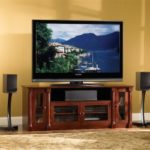Features of the curved TV
It is enough to stroll around the hall of the modern department of home appliances to make sure that models with a curved screen occupy the leading positions on the TV windows. They first appeared in 2013 - with this invention, manufacturers tried to improve the effect of presence, and reduce distortion. How successful the idea can be understood from further analysis.
Content
Advantages and disadvantages of innovative technology
It is a little wrong to interpret the translation of the term curved as “curved” - devices are more likely concave. Such monitors have long been used in cinemas, fulfilling the specific task proposed to them - reproducing the light projecting on them without distortion.In addition, it is for such an entertainment venue, this technology expands the field of view.
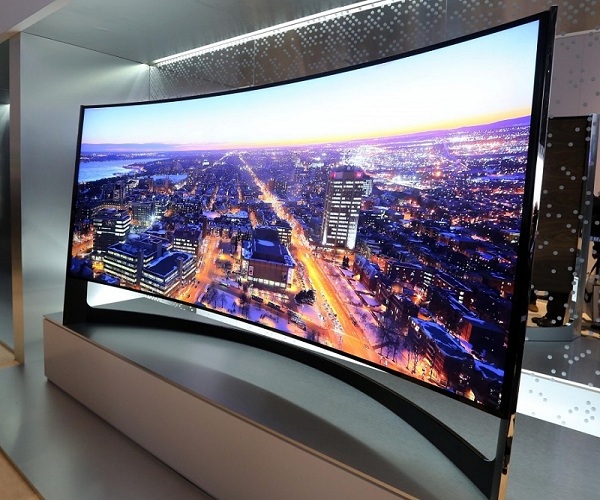
With the cinema everything is clear. Home TV with a curved screen, according to assurances of advertising, is able to immerse the viewer into the reality of what is happening on the screen. Other benefits are promised:
- increased viewing angles;
- contrast enhancement;
- glare reduction;
- increase the visual space of the display;
- reduction of optical distortion.
Some manufacturers are so confident in the capabilities of their creations that they focus only on such panels. For example, in its 9000th line all TVs from Samsung are like that. However, consumers still do not understand why they should be delighted with such an offer. There are a lot of reasons for this - almost every one of the stated advantages can be disputed.
Perception of what is happening on the TV panel
Will the curved version of the picture depend on the angle of view? The fact is that when you look at the usual flat version, we perceive the picture as ideal only at right angles, that is, sitting exactly in the center. A slight deviation from this rule, and even the perception of the peripheral part of the screen already speaks about distortions.Of course, they are insignificant and are not perceived by the eyes of a simple inhabitant.
With a cylindrical shape of the screen, the eyes of the viewer are located in the center of the circle, which means that his eyes will always fall at a right angle. This allows manufacturers to claim improved color accuracy. throughout the area curved tv screen.
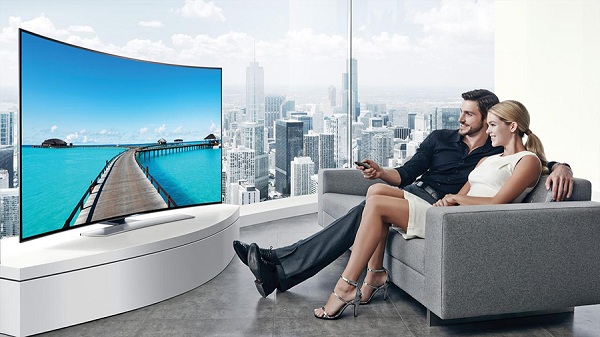
But all this applies if the conditions are close to ideal: one person is sitting in front of the TV motionless. In life, a few people usually look at him, and even that, from different corners of the room.
Immersion in view
LG defines the concept of "mountain line"- that is, equidistant points from both eyes of the viewer (in fact, the viewer is in the center of the arc). So, the calculations showed that when viewed from a distance of two meters, the screen of 55 inches will touch flat. It turns out that the deliberate zagutenie of the screen - just a design move. To make it seem to the user that he is immersed in additional reality, a model with a diagonal of at least 100 inches is needed, which is hardly suitable for an ordinary city apartment.
If the user wants to “immerse” in the viewed image, he must also sit at a certain distance from the equipment.Matters and screen resolution:
- with HD it will be 3, 23 meters;
- with Full HD - 2.18 meters.
Such an immersion effect will be perfectly felt in models with 4Kwhich have a large diagonal.
Increase angles and play on contrast
Does it increase viewing angles at the screen of this form? Here again, it depends on where the user is looking at him. Calculations are conducted for one, but in fact in real life several family members from different corners of the room can watch TV at the same time.
A simple example: the viewer sits to the left of the center of the screen. A simple calculation shows that in this case an acute angle will form from the right edge, and for the left edge it will become obtuse (and exactly the opposite). This means that one of the sides is practically parallel to the line of sight, which is very inconvenient.
Concerning contrast ratiothen in any TV it can be lost on the sides. In the concave version this will be noticeable if you sit close to the monitor. But since no one is watching television at a distance of half a meter, even with a 27-inch monitor, such problems should not arise.
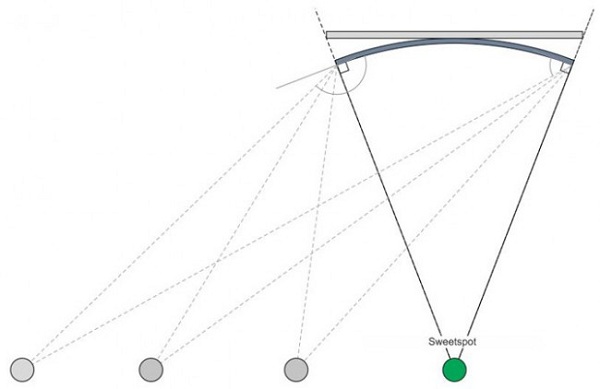
All calculations are provided again for one person. In practice, other viewers will not fall into such a comfortable viewing area.Only one conclusion suggests itself: for the benefits to become obvious, you need to sit as close as possible to the TV.
Will there be highlights
To avoid reflections from outside sources, it should be the other way round. further from the screen. It's all about the properties of the curved surface of the device - it changes the angle of reflection of light rays. According to the optical laws, the concavity will set the focal point at a distance equal to half the radius of curvature extending from the center of the screen. Consequently, the farther the viewer sits from the screen, the more blurred the glare becomes.
The screen seems bigger
Here, advertising does not lie: the user will feel that the screen is larger than it really is. With the only difference - it all depends on the distance from the device.

For example, when viewing a 55-inch model 5 meters from a TV device, the screen will appear to have visually increased by 3%. And already in three meters this effect will increase to 9% (after all, the angle will increase at the same time).
Less optical distortion
A curved TV can reduce the amount of optical distortion? Marketers draw an analogy with the cinema: they say that there is such a screen.But at home everything happens exactly the opposite: this screen will only increase them.
This is especially noticeable at a very close examination of the image.
Knowledge of the physical laws helps to understand that such a technique creates an appropriate optical illusion that connects peripheral vision. That is why the image seems more realistic. The best effect is provided by technologies with high image quality, which today can only be attributed to 4K.
Overview of the best 4K models with a curved screen
One of the most advanced options is the Samsung UE40KU6300U with a diagonal of 40 inches. The 16: 9 device format will make the picture look as close to natural as possible. This unit has a TV tuner and good stereo sound, which means it can claim the title home theater. There is support for Wi-Fi and SMART TV. But the viewing angles, according to users, are not large enough. You can buy such a device for 39,400 rubles.
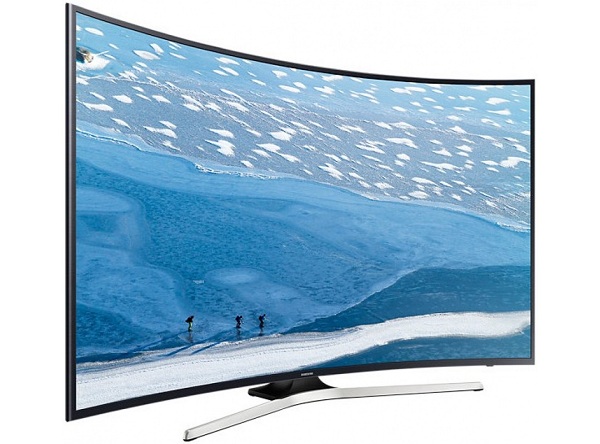
Samsung TV UE40KU6300U
The Philips 55PUS8700, in addition to the 55-inch curved TV screen, also has excellent sound support in the form of five speakers and one subwoofer. LCD panel has improved brightness, and the additionally used Ambilight illumination will only increase the realism of the image. There is a SMART TV and the ability to interact with other devices via Wi-Fi - for example, you can easily connect tablet. By the way, you can view any formats on it - this will only increase the realism of the picture. The cost is several times more expensive - the device will cost 95,000 rubles.
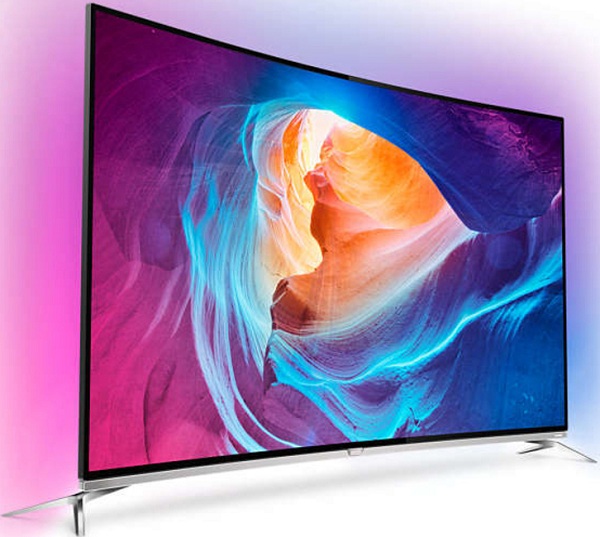
Philips TV 55PUS8700
The best 4K device today is the LG OLED65C6V by 65 inches. Used here OLED technology. Detailing the image is amazing. There is also a convector function from 2D format to 3D. Four speakers will achieve the effect of home theater. There is support for Wi-Fi and 3 HDMI-output, which allows you to transfer high-definition images. Finally, management takes place using webOS, which allows the device to become an excellent multimedia center with Internet surfing capabilities.
It can be assumed that the cost of such a flagship will be rather big - 257,700 rubles.

TV LG OLED65C6V
So, the new trend for curved TVs is fully justified in models with large diagonals - there will be better properties. But it is worth being prepared that such a technique would be inconvenient. set on the wall, and bending is able to limit the view (which will appear at an angle of 35%). Models with a standard direct screen you can choose in our big tv review.

/rating_off.png)






